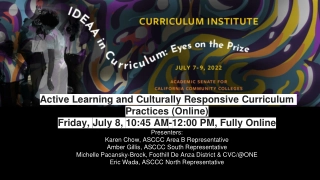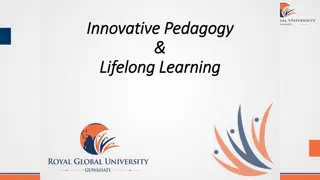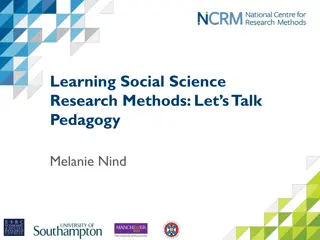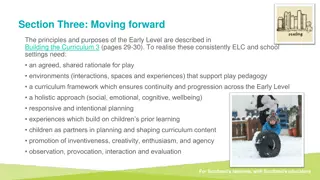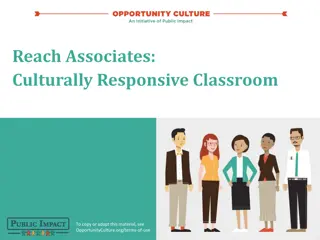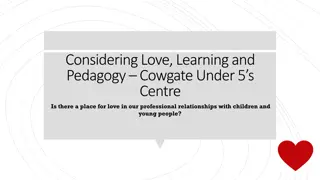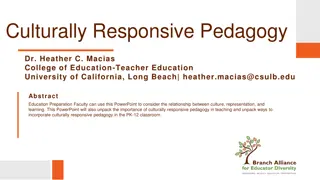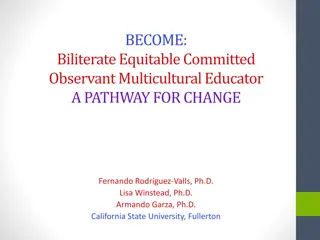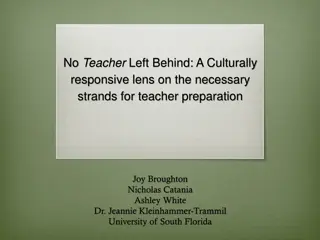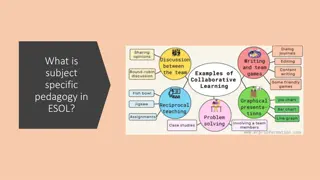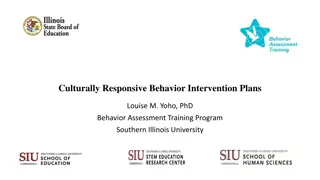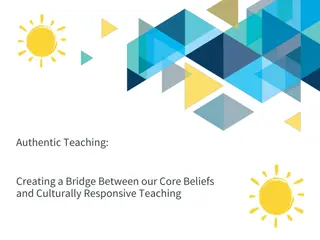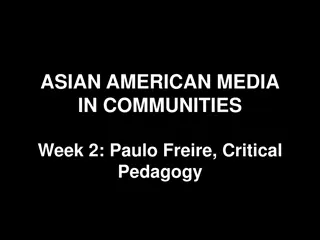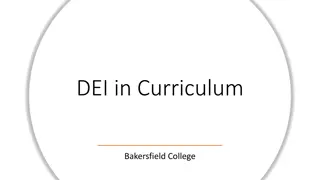Understanding Culturally Responsive Pedagogy and Brain-Based Learning
This comprehensive guide explores the integration of culturally responsive pedagogy and brain-based learning to empower students by retaining their cultural identity while succeeding academically. Key concepts include the role of culture in learning, information processing models, working memory, and schema construction processes. Dr. Gloria Ladson Billings, Dr. Lisa Delpit, and Dr. Zaretta Hammond's methodologies are highlighted to enhance understanding and application in education.
- Culturally Responsive Pedagogy
- Brain-Based Learning
- Education Psychology
- Schema Construction
- Working Memory
Download Presentation

Please find below an Image/Link to download the presentation.
The content on the website is provided AS IS for your information and personal use only. It may not be sold, licensed, or shared on other websites without obtaining consent from the author. Download presentation by click this link. If you encounter any issues during the download, it is possible that the publisher has removed the file from their server.
E N D
Presentation Transcript
How do we teach using culturally responsive pedagogy and the brain?
Quick introduction Taught social studies for 11 years in SE Wisconsin Masters - brain-based learning from Cardinal Stritch University. Ph.D. - Indiana University - minor in learning sciences. My research: how students and adults construct knowledge. Teach social studies methods and educational psychology
Culturally responsive pedagogy Dr. Gloria Ladson Billings, Dr. Lisa Delpit, Dr. Zaretta Hammond Empowering students to retain their cultural identity and succeed academically. Role culture plays in learning and knowledge construction. Culture = key lens children use culture to construct an understanding of the external world (Schema) Language = key tool of knowledge construction. Language describes the internal and external world - Schema Code switching constructing knowledge in vernacular and discipline. Children cannot leave their culture at the schoolhouse door.
Information Processing Model Memory system (Wolfe and Hammond) Cognitive development is expanding the capacity and speed of the memory system Schema construction (new schema is constructed on existing schema) influenced by culture 2 days Declarative v. Procedural Culture influences encoding of memory Cerebrum Decode the world around us Culture influence decoding RAS, Limbic 5-7 items 18 sec. Culture influences emotional response Limbic system 5-9 cognitive tasks 4 processes Culture influences processing Cerebrum Sensory Data Short- term Long- term Working
Working Memory 5-9 cognitive tasks (cognitive task anything that requires effort to perform) Cognitive Load (the limit of the number of tasks) Automation of tasks eases cognitive load Working Memory is Loopy Phonological Loop Visual Spatial Loop Episodic Buffer - Context
Working Memory Schema construction Process sensory data into meaningful knowledge Schema Construction Assimilation new information is added to existing schema Accommodation new information doesn t fit changes schema or create new schema Transformation new information leads to dramatic changes to existing schema/inter-related schema
Working Memory: How We Teach? Hammond Chewing and Chunking/ Wolfe 4 Cognitive Processes Chunking: Getting students to connect and use new information (making new information digestible) Organization (graphic organizers, Venn, T-charts, word webs, timelines, . . . ) Rehearsal (entrance and exit tickets, bell ringers, discussions, twihistory, . . . ) Elaboration (journaling, electronic threads, twihistory, . . . ) How do we teach for Chunking?
Working Memory: How We Teach? Hammond Chewing and Chunking/ Wolfe 4 Cognitive Processes Chewing: Getting students to actively process and use new information Rehearsal (pre-made skits, role-plays, simulations, 3- or 5-min writes, . . . ) Elaboration (deliberation, SAC, legislative hearings, DBQs, . . . ) Manipulation (scenarios, SAC, deliberations, simulations, student written skits, student directed role play . . . How do we teach for Chewing?
What does this mean for Social Studies? Wrong answers are constructed . . . Real social studies requires fluid intelligence Research shows children only construct fluid intelligence through challenge and problem solving Students do need to memorize but for a higher purpose Citizenship The culture of the child and their community is an asset It influences how they decode the external world
Special Thanks Joe Schmidt Social Studies Specialist Western Maine Regional Representative Maine Department of Education Zaretta Hammond Ready4Rigor Patricia Wolfe Brain Matters
Questions? Any questions? You can contact me: dean.vesperman@uwrf.edu







